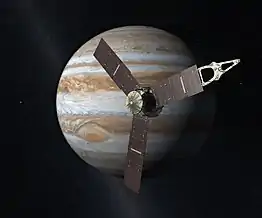2MASS J2126–8140
2MASS J21265040−8140293, also known as 2MASS J2126−8140,[3] is an exoplanet orbiting the red dwarf TYC 9486-927-1, 111.4±0.3[5] light-years away from Earth. It has both the longest (~900 thousand years) and the widest orbit (>4500 AU) of any known planetary mass object. Its estimated mass, age (10-45 million years), spectral type, and Teff are similar to the well-studied planet β Pictoris b.[3]
| Discovery | |
|---|---|
| Discovered by | K. L. Cruz, J. D. Kirkpatrick, A. J. Burgasser [1][2] [3] |
| Discovery date | 2009 (as a Brown Dwarf), 2016 (as an exoplanet)[1] |
| Direct imaging | |
| Orbital characteristics | |
| 6,900[3] AU (1.03×1012 km) | |
| Physical characteristics | |
| Mass | 13.3 (± 1.7) [1] MJ |
| Temperature | ~1,800 K (1,530 °C; 2,780 °F)[1] |
Spectral type | L3.0[4] |
| 20.72 (G-band)[4] | |
References
- "Planet 2MASS J2126-8140". exoplanet.eu. Retrieved 2016-01-27.
- Cruz, K.L.; Kirkpatrick, J.D.; Murphy, S. (2009). "Young L Dwarfs Identified in the Field: A Preliminary Low-Gravity, Optical Spectral Sequence from L0 to L5". Astron. J. 137 (2): 3445. arXiv:0812.0364. Bibcode:2009AJ....137.3345C. doi:10.1088/0004-6256/137/2/3345. S2CID 15376964.
- N. Deacon; J. Schleider; S. Murphy (2016). "A nearby young M dwarf with a wide, possibly planetary-mass companion". Monthly Notices of the Royal Astronomical Society. 457 (3): 3191. arXiv:1601.06162. Bibcode:2016MNRAS.457.3191D. doi:10.1093/mnras/stw172. S2CID 18220333.
- Jones, H R A.; Caballero, J. A.; Beamín, J. C.; Barrado, D.; Sarro, L. M.; Marocco, F.; Smart, R. L. (2019), "The Gaia Ultra-Cool Dwarf Sample – II: Structure at the end of the main sequence", Monthly Notices of the Royal Astronomical Society, 485 (3): 4423–4440, arXiv:1902.07571, doi:10.1093/mnras/stz678, S2CID 119421722
- Brown, A. G. A.; et al. (Gaia collaboration) (August 2018). "Gaia Data Release 2: Summary of the contents and survey properties". Astronomy & Astrophysics. 616. A1. arXiv:1804.09365. Bibcode:2018A&A...616A...1G. doi:10.1051/0004-6361/201833051. Gaia DR2 record for this source at VizieR.
This article is issued from Wikipedia. The text is licensed under Creative Commons - Attribution - Sharealike. Additional terms may apply for the media files.


